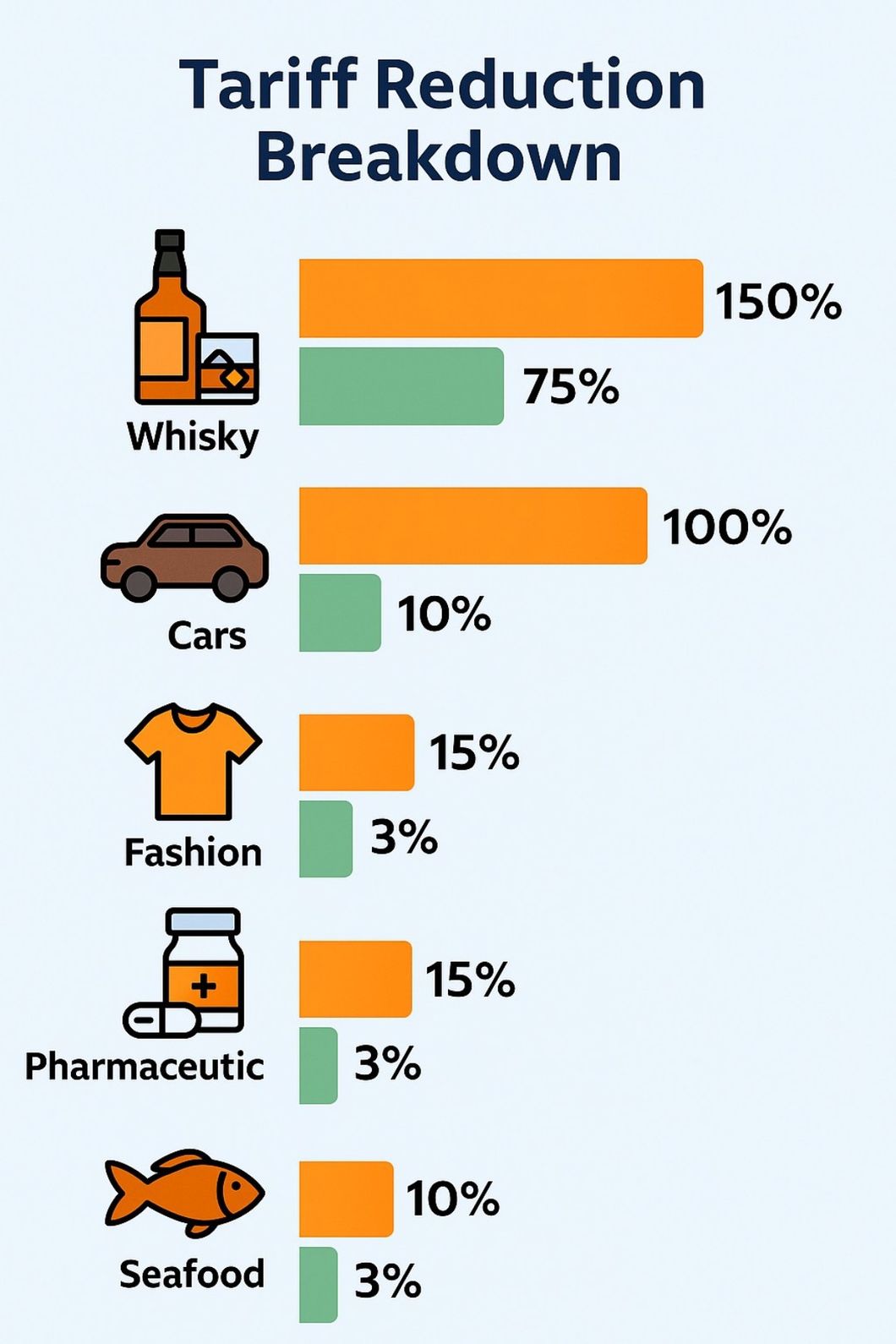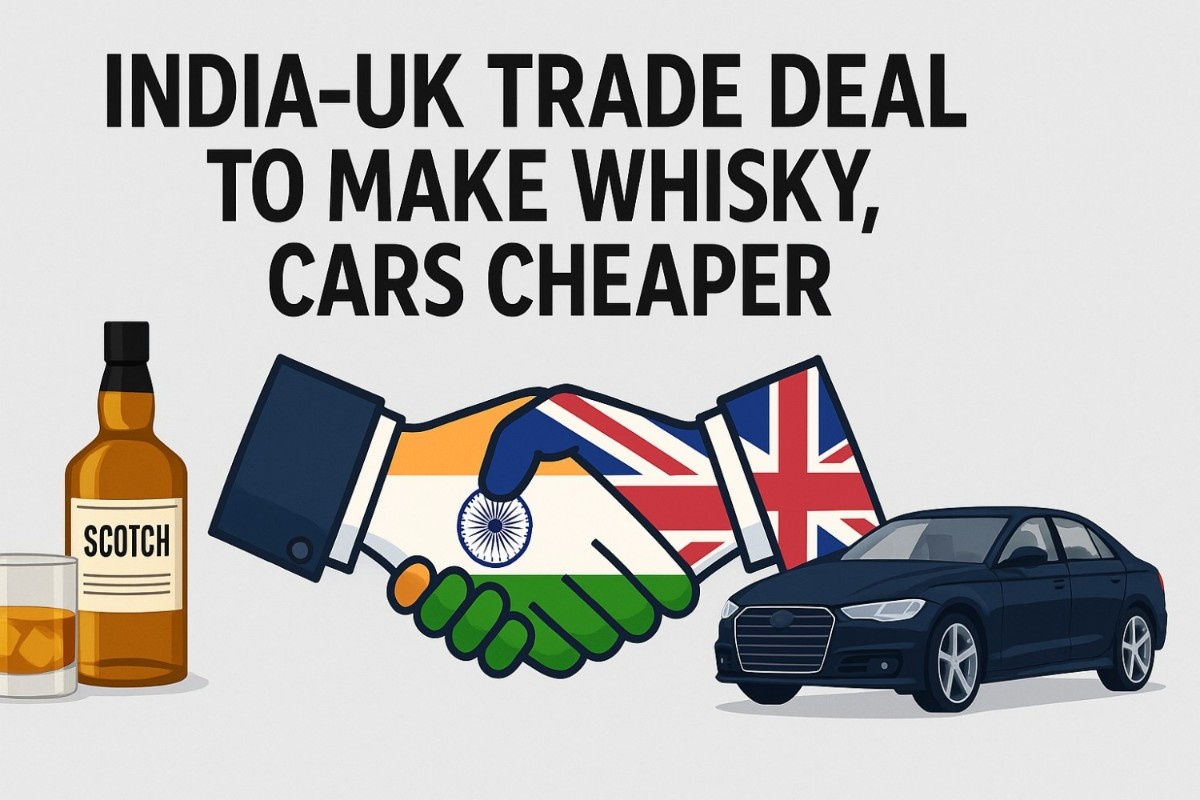India and UK Sign Historic Trade Deal
In a major economic milestone, India and the United Kingdom have officially signed a Free Trade Agreement (FTA). The deal, finalized on 24 July 2025, is set to dramatically boost India UK trade by reducing or eliminating tariffs on a wide range of goods and services. This move marks the culmination of over three years of negotiations that began in January 2022.
The agreement is expected to double bilateral trade between the two nations to $120 billion by 2030. It will also create new economic opportunities for exporters, manufacturers, consumers, and small businesses in both countries.
What Will Get Cheaper in India?
This historic India UK trade pact promises relief to Indian consumers by cutting import duties. Here’s what’s expected to become more affordable:
- Scotch whisky and gin: Tariffs will be halved from 150% to 75%, and later reduced to 40%. A bottle priced at ₹5,000 may now cost ₹3,500.
- Luxury cars: Vehicles from UK brands like Jaguar Land Rover and Rolls-Royce will see import duty reduced from 100% to as low as 10% under a quota system.
- Gourmet food and beverages: UK-imported products such as salmon, lamb, biscuits, chocolates, and soft drinks will carry lower duties.
- Cosmetics and medical devices: With tariffs slashed from 15% to 3%, premium products from UK brands will become more affordable.
- Fashion and home goods: Branded clothing, footwear, and furniture imported from the UK will now enter the Indian market at lower costs.
This change is expected to transform India UK trade into a consumer-centric relationship, offering premium British goods at better prices.

How Indian Exporters Will Benefit
While Indian consumers will enjoy lower prices, Indian exporters stand to gain even more. Here’s how Indian sectors will benefit from this FTA:
1. Textile and Apparel Industry
Indian textile exports to the UK will now enjoy zero tariffs, down from the earlier 8–12%. Products like curtains, bedsheets, and garments will become more competitive than those from Bangladesh or Vietnam. Cities like Tiruppur, Surat, and Ludhiana are projected to experience up to 40% growth in textile exports in the next three years.
2. Jewellery and Leather Goods
Customs duties on Indian jewellery and leather products have been removed. MSMEs and luxury brands alike will gain access to a lucrative UK market without tax burdens. The India UK trade corridor is expected to become a key entry route into the broader European luxury goods market.
3. Engineering and Auto Components
UK has eliminated import taxes on Indian machinery, industrial tools, and auto parts. Manufacturing hubs like Pune, Chennai, and Gurugram are expected to witness higher production and export volumes.
4. Pharmaceuticals and Medical Equipment
India’s pharmaceutical companies will benefit from a streamlined registration process in the UK. Generic drugs and medical devices will get faster approvals for NHS use. This will make India a more prominent player in the UK healthcare supply chain.
5. Agriculture and Seafood
UK has dropped duties on basmati rice, shrimp, premium tea, and spices from India. States like Assam, Kerala, Gujarat, and West Bengal are expected to see an uptick in agro-export revenue.
6. Chemicals and Specialty Materials
Tariff cuts on plastics, agrochemicals, and specialty chemicals will promote exports from Gujarat and Maharashtra, India’s industrial heartlands. The goal is to double chemical exports to the UK by 2030.
7. Green Energy and Technology
The deal opens doors for joint ventures in clean energy, including solar, electric vehicles, and green hydrogen. UK investors are eyeing India as a top destination for renewable tech development. This will promote sustainable India UK trade partnerships focused on innovation and climate resilience.
Economic Impact on India
The FTA has far-reaching implications for India’s economy. These include:
- Massive export growth: With 99% of Indian goods entering the UK at zero tariff, sectors like textiles, leather, and engineering are poised for a boom.
- Job creation: Labor-intensive industries such as textiles and leather could see employment double, boosting rural and semi-urban economies.
- MSME upliftment: Around 60 million Indian MSMEs, which contribute 40% of exports, will gain new access to UK markets with better margins.
- Foreign investments: UK businesses are expected to increase investments in India’s IT, finance, and renewable sectors. This will aid India’s manufacturing and service sectors.
- GDP growth: This deal is projected to drive 15% annual growth in bilateral trade, helping India approach its $100 billion trade goal with the UK faster.
When Will the Agreement Be Enforced?
Though the agreement was signed on July 24, 2025, implementation is expected to take up to one year. The Indian Cabinet has already approved it. Final approval from the UK Parliament is awaited for it to become operational.
A Look at the Timeline
Negotiations for this India UK trade agreement began in January 2022. This is India’s fifth major FTA in a decade, following deals with Mauritius, UAE, Australia, and EFTA. India is also in active talks with the European Union for a broader economic partnership.
Conclusion
The India UK trade agreement is a win-win deal that benefits consumers, exporters, MSMEs, and investors. It not only reduces costs but strengthens strategic economic ties. As implementation nears, both nations look forward to a prosperous future built on trade, trust, and mutual growth.
